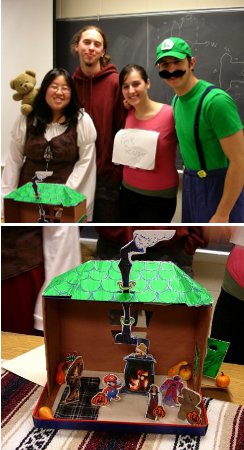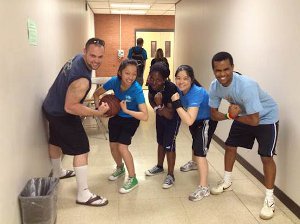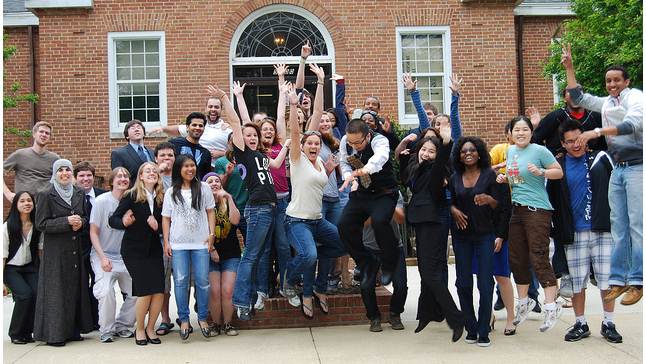How UMBC’s Chemical, Biochemical, and Environmental Engineering Department is using innovative teaching techniques to engage and inspire undergraduates.
Gone are the days of stuffy lectures and drowsy students. In UMBC’s Chemical, Biochemical, and Environmental Engineering Department, cutting-edge teaching methods, innovative classroom models, writing intensive courses, and special seminars to increase transfer student success are just a few tactics being used to engage and inspire future engineers.
Teaching Techniques
Innovation starts with the very first course taken by engineering majors: ENES 101: Introductory Engineering Science. Taught by Dr. Joshua Enszer and Dr. Taryn Bayles, the course is an introduction to essential concepts and computer tools. Students work in teams on projects like building K’NEX towers and making water balloon catapults.
Dr. Bayles just started using “Just in time teaching” to integrate engineering theory and computer programming in MATLAB with design projects in ENES 101. Instead of teaching material in one big daunting block, Bayles doles it out as needed. As a result, the class lecture sequence has shifted to Monday through Friday so that lectures and discussions are in sync across all the sections.
In ENCH 215: Chemical Engineering Analysis–an introductory course that teaches chemical engineering calculations and analysis–Dr. Bayles is experimenting with the “Lecture on Demand” technique. It allows students to request targeted mini-lectures on difficult subject matter, making better use of valuable classtime.
Bayles recently started quizzing students using the chemical engineering concept warehouse, an online question bank that helps educators identify areas of difficulty in the curriculum. The questions, which students answer in class using clickers, help gauge learning patterns and common areas of difficulty among the class.
In Enszer’s ENCH 225: Chemical Engineering Problem Solving and Exp Design and ENCH 442: Chemical Engineering Systems Analysis have adopted the “inverted classroom” model for MATLAB sessions. In class lectures have been replaced with video lectures that students watch at home. Students come to class knowing the material, making class time an opportunity to ask professors questions and work on group projects.
The department has introduced an overarching project that spans three core courses as a way to help students see how the course material connects. The project, which deals with how to safely remove heat from a chemical reaction, will occur in ENCH 427: Transport Processes II, which deals with heat and mass transfer, ENCH 440: Chemical Engineering Kinetics, which deals with chemical reactions, and ENCH 442: Chemical Engineering Systems Analysis, which deals with process control and safety.
 Dr. Mariajose Castellanos has totally re-designed her ENCH 300: Chemical Process Thermodynamics class. What was once purely lecture-based in now an interactive course that livens up a subject that has a reputation for being difficult and non-intuitive, admits Castellanos.
Dr. Mariajose Castellanos has totally re-designed her ENCH 300: Chemical Process Thermodynamics class. What was once purely lecture-based in now an interactive course that livens up a subject that has a reputation for being difficult and non-intuitive, admits Castellanos.
Group projects (pictured left) are encouraged to be as creative as possible. One year Luigi, the pink power ranger, and a teddy bear showed up to talk to the class about thermodynamics.
Class kicks off with reading group sessions where Castellanos poses questions like “what was your favorite equation?” to make students think critically about the assigned reading. Afterwards, students jot down a new concept that they didn’t quite grasp from the reading. Rifling through the entries, Castellanos bases her lecture around those unlcear concepts. The strategy is similar to lecture on demand, and lets Castellanos focus her lectures on topics that are hard for the majority of the class.
Castellanos has also added an online discussion board. On it, students write about examples of thermodynamics found in everyday life. Students have drawn connections to out-of-the-box things like musical instruments and erasers, says Castellanos. And even though she only requires a mere six posts per student per semester, she says she is already unable to keep up with the outpouring of enthusiastic and creative responses.
Write on
Castellanos’ third new addition is a reflective writing assignment. In it, students reflect on what they've learned that week. “I want them to really feel free to write what they want,” explains Castellanos, so she only takes six of the twelve assignments for a grade.
The writing assignments help students connect concepts between classes and it makes them reflect on how they learn, says Castellanos. Reading them allows her to get to know her students and give them constructive feedback, which, in a class of more than sixty can be difficult to do one-on-one.
Dr. Bayles also assigns reflective writing pieces in ENCH 427: Transport Processes II, a class that covers various forms of mass transfer. Handing back lab reports that students turned in as freshmen, she asks them to reflect on how far they’ve come. It is embarrassing and surprising for most, explains Bayles. But, it’s a chance for the students to understand their academic growth and in the end, it’s encouraging to see their progress.
Students exercise their oral communication skills through the high school outreach program that Bayles started in 2003. Students visit high schools (sometimes their own) and teach Chemical Engineering concepts like the applications of heat and mass transfer to a class of highschoolers. They learn how to “convey that info to an audience that doesn’t have that technical knowledge,” she says.
In ENCH 437L: Chemical Engineering Laboratory, Dr. Jennie B. Leach has introduced Draft Conferences. The short student-teacher meetings are a chance for Leach to give feedback on in-progress lab reports. She has noticed overall improvement on the assignments since the conferences began.
“It puts more responsibility on the students to play an active role in the feedback process and therefore is a lot less time consuming for the instructor as no comments are written,” explains Dr. Leach. “Also, [students] get to see a reader’s reaction to their writing and be guided in the critique and editing process.”
Fostering communication skills in technical-minded students is a priority of the department. Currently, the CBEE department has three writing intensive courses; It is pulling for a fourth by adding written lab reports, essays, and technical writing training to ENCH 225. There's also a collaboration in the works with English Professor of the Practice Christopher Corbett.
Transfer Student Success
In an effort to increase transfer student success, the CBEE department offers a new one-credit Transfer Student Seminar (TRS 201). The course is tacked on to Dr. Bayles’ ENCH 215: Chemical Engineering Analysis—the first in a six semester sequence of Chemical Engineering courses—and goes over core concepts that might not have been emphasized at the students’ previous schools.
Held for an hour on Fridays, the class features a peer mentor. This fall it was Rima Abouzeid (CE '14), a transfer student herself. “I work with Dr. Bayles to try to always create a supportive environment for the students and help them do better in this class, and provide a strong background to be successful in their future classes,” explains Abouzeid. “I also try to always be a positive role model and be a good resource for any problems that might arise during the semester.”
Abouzeid explains that the biggest challenges facing transfer students is that expectations between community college or smaller colleges and the expectations at UMBC are so different. “Hard work is the key to success,” she says. The main section of the course also has two undergraduate teaching fellows—Chemical Engineering seniors that offer additional office hours. Which means that in addition to Dr. Bayles, the nearly one-hundred students in ENCH 225 have three other resources for help and guidance.
Industry Simulation
CBEE courses that simulate what it’s like to work in the industry give students practical experience and an undeniable edge. Taken in their senior year, the classes get students ready for the “real world.”
That is the goal of the Chemical Engineering Capstone courses. The two part capstone puts Chemical Engineering majors into teams to work on projects that they might encounter in the industry. The courses are run like businesses, where professors acts as CEOs and commission students to design products or processes to meet a need. Throughout the semester, students present on their progress, write reports, and evaluate their work and teammates.
Drawing on more than thirty-two years of industry experience, Dr. Joseph Loehe acts as the “director of engineering” in ENCH 444. Instead of lecturing, he gives students guidance and technical advice along the way. If it seems like extra help is needed, he’ll give a targeted mini-lecture on a specific subject.
“I’m trying to give them technical self-confidence,” explains Loehe, by giving them the freedom to work through problems with their teammates. Loehe puts students in teams of five with one team captain. “Part of this capstone experience is learning how to be a group member,” he says. Peer evaluations are a critical consideration in a student’s overall grade.
 Teamwork and effective communication is also the focus of Capstone part two, ENCH 446 taught by Dr. Mariajose Castellanos. Focused around one semester-long group project, the course culminates in an anticipated group presentation to the entire CBEE department.
Teamwork and effective communication is also the focus of Capstone part two, ENCH 446 taught by Dr. Mariajose Castellanos. Focused around one semester-long group project, the course culminates in an anticipated group presentation to the entire CBEE department.
Projects—last spring it was turning liquid gas into petroleum–are also group based, but instead of assigning a group leader, students rotate roles. There’s a firing policy. “It’s like soccer,” she says: two yellow cards and you’re out. And at the end of the semester, Castellanos has students reflect on their success as a team with a creative presentation to the rest of the class.
One group, for example, that had trouble getting along wore sunglasses as a symbol of their blindness to one another during the semester. Another team came into the classroom dribbling basketballs and compared their group dynamics to a basketball team (pictured right). They weren’t passing the ball to one another, they said.
Next, students produce a digital story, a three to five minute video that recaps their experiences during the semester. They re-enact group fights, add music and graphics. “It’s such a cathartic moment for them,” explains Castellanos, because it marks the end of a class that marks the end of their college careers.
After a semester of hard work, group projects are presented during the last week of class. “I make sure that the whole department has been invited,” she says. Professors, staff, and students gather. There’s food. The students come early to prepare, dressed in suits and color coordinated outfits. “It’s culturally a big deal,” she says. Each team is evaluated by the audience, who answers questions like “would you hire the team?”
The event is an example of how teachers, like Castellanos, are trying to create a tight knit community within the department. Along with engaging classes and dedicated professors, helping students feel like part of a family is essential to their success. "I really do believe that it makes a big difference."
